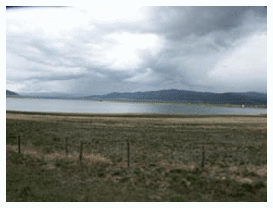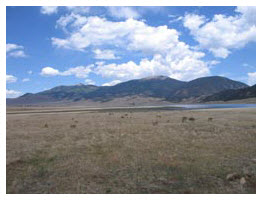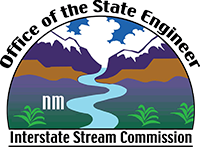Interstate Stream Commission
- OSE Home
- About ISC
- Basins
- Canadian River Basin
- Eagle Nest Reservoir
Canadian River Basin - Eagle Nest Reservoir
Set in the scenic Moreno Valley and surrounded by two of the state's highest peaks, Baldy Mountain and Wheeler Peak, this 2,400-acre lake is known for its kokanee salmon and rainbow trout fishing.
 At 8,300 feet in elevation, Eagle Nest Reservoir offers a cool retreat from the summer heat for fisherman, boaters and wildlife enthusiasts. An abundance of animals—elk, bear, mule deer, eagles, turkeys and other birds—inhabit the area, making Eagle Nest Lake an ideal location for wildlife viewing. In the winter, ice fishing and snow mobiling are popular sports when ice thickness permits. Snow mobiling is limited to the lake surface.
At 8,300 feet in elevation, Eagle Nest Reservoir offers a cool retreat from the summer heat for fisherman, boaters and wildlife enthusiasts. An abundance of animals—elk, bear, mule deer, eagles, turkeys and other birds—inhabit the area, making Eagle Nest Lake an ideal location for wildlife viewing. In the winter, ice fishing and snow mobiling are popular sports when ice thickness permits. Snow mobiling is limited to the lake surface.
A Brief History
Charles Springer, a rancher and entrepreneur in the Cimarron Valley in northern New Mexico, and Neal Solvangen, engineer, built a dam in 1916 on the Cimarron River to capture surplus flows. Eagle Nest Dam and Reservoir can hold up to almost 70,000 acre-feet of water. To help finance the dam, Springer sold some water rights to water from Eagle Nest to farmers. Those original deeded rights became know as the "vested rights".
In 1951 the State District Court adjudicated the entire Cimarron Basin, confirming Springer’s right to store surplus and flood flows in Eagle Nest for later use under State Engineer Permit No. 71. Court cases continued, even moving up to the New Mexico State Supreme Court by 1990.
 Over the years, Eagle Nest water rights have been transferred from farming and ranching to meet the needs of growing populations as far away as the cities of Raton and Springer. The Villages of Angel Fire and Eagle Nest have sprung up around the lake and bought rights to Eagle Nest water. Contract, or "Tier-Two" rights, for additional bulk water deliveries were sold.
Over the years, Eagle Nest water rights have been transferred from farming and ranching to meet the needs of growing populations as far away as the cities of Raton and Springer. The Villages of Angel Fire and Eagle Nest have sprung up around the lake and bought rights to Eagle Nest water. Contract, or "Tier-Two" rights, for additional bulk water deliveries were sold.
The City of Raton paid to acquire over 3,000 acre-feet of Eagle Nest water rights and to store and protect any unused allocations. Other municipalities and users have taken the same route.
Shortly before the state acquired the reservoir in 2002, Raton filed a court action to confirm their right to private storage in Eagle Nest. Court-ordered mediation failed. And it looked like the water users in the area were facing years of litigation.
The state purchased Eagle Nest resevoir in 2002, and the Game and Fish Commission now own the reservoir. The Interstate Stream Commission is charged with operating the reservoir and administering its water rights. It provides water to fulfill approximately 16,000 acre-feet of water rights demand per year, for both municipal and agricultural uses.
THE SETTLEMENT
The New Mexico Interstate Stream Commission (ISC) was tasked with operating and maintaining Eagle Nest Dam and reservoir. At the same time Eagle Nest water users approached former New Mexico Governor Richardson and asked his help to solve their never-ending water litigation.
The Interstate Stream Commission, the New Mexico Department of Game and Fish, and the Governor’s Director of Policy gathered the water users together, they presented initial modeling that confirmed there simply wasn’t enough water to meet even the original vested rights, much less additional rights sold over the years.
After two years of litigation including nine months of intense, difficult negotiations the water users now have an agreement on water deliveries that can be met by Eagle Nest Reservoir.
Except in the most severe, extended droughts, modeling estimates there will enough water in the lake to sustain the fisheries and recreational values for which the state purchased the Reservoir.
The basics of the settlement include:
- All users share shortages, in amounts determined by how much water is in the lake on June 1st of each year.
- All users are treated equally, including the Tier-Two users.
- Adjustment of allocations and reductions in private storage protect the original vested users.
The Eagle Nest Reservoir Water Rights Settlement was signed on June 2, 2006.
